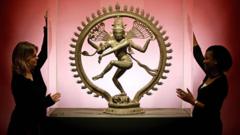The Chola dynasty, active during the Middle Ages, transformed southern India into a cultural and economic powerhouse, as reflected in their monumental architecture, innovative administration, and global trade links.
The Chola Dynasty: India's Hidden Gem of Medieval Innovation and Influence

The Chola Dynasty: India's Hidden Gem of Medieval Innovation and Influence
Exploring the remarkable legacy of the Chola dynasty, one of history's unsung players in shaping the medieval world.
In the year 1000 CE, while Europe was undergoing significant upheaval, the Chola dynasty of southern India was laying the foundations for a flourishing empire. Under Emperor Rajaraja Chola, a colossal temple dedicated to the Hindu god Shiva was completed, standing 216 feet tall and constructed from an impressive 130,000 tonnes of granite. The Brihadishvara temple, now a UNESCO World Heritage site, was adorned with magnificent bronze sculptures and a treasury filled with gold and silver, establishing Rajaraja as one of the wealthiest rulers of his time.
The Chola dynasty rose from being a minor power to a formidable force through ingenuity and relentless expansion, notably marked by the innovative roles women played within society. Chola queens, including Rajaraja's great-aunt, Sembiyan Mahadevi, played pivotal roles in promoting their lineage’s devotion to Shiva and transforming agriculture and urban development. Sembiyan notably led efforts to refurbish ancient shrines, reinforcing Chola identity, and devotion to the deities.
Rajaraja Chola expanded the empire’s territory in the late 990s by conquering parts of the Deccan Plateau and establishing a significant presence in the island of Lanka. His military campaigns produced vast wealth that was channeled back into the founding of the Brihadishvara temple and the sustainable management of the region, providing 5,000 tonnes of rice every year to support a thriving community.
Furthering this legacy, Rajendra Chola, Rajaraja's successor, built alliances with Tamil merchant groups, enabling the Cholas to establish trade connections that would mirror later colonial enterprises. He led expeditions across Southeast Asia, engaging in commerce and expanding Tamil influence as far as modern-day Myanmar and Thailand.
Despite a lack of a formidable navy, Tamil merchants flourished during the Chola rule, dominating trade routes and establishing businesses in ports far beyond their homeland. Their legacy continued into the 13th Century, significantly impacting trade in China under Mongol rule and setting a precedent for the future of Indian merchants abroad.
The Chola dynasty's vision reached far into the realm of culture and arts. The stunning bronzes and sculptures produced during this period showcase unparalleled skill and artistic innovation, with Tamil poets pioneering narratives that intertwine history and mythical realism. The remarkable urban planning during the Chola era saw the rise of temple towns that served as cultural hubs, promoting diversity and interaction among various religious and ethnic groups.
The artistic and architectural advancements realized by the Cholas not only echoed through the ages, but set a standard for subsequent civilizations. Collectively, the profound impact of the Chola dynasty established southern India as a centre of economic prosperity and cultural vigor that would influence the global landscape for centuries to come, making their remarkable achievements a critical chapter in world history yet to be fully acknowledged.





















